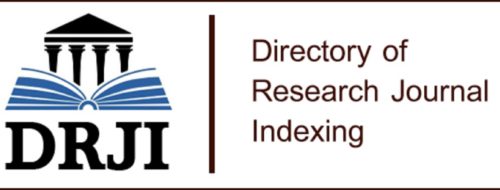Diseño de un filtro anaerobio de flujo ascendente para el tratamiento de aguas residuales
DOI:
https://doi.org/10.46296/ig.v5i10edespnov.0075Palabras clave:
digestión anaerobia, diseño de filtro, filtro anaerobio de flujo ascendente, FAFA, tratamiento de aguas residualesResumen
El filtro anaerobio de flujo ascendente (FAFA) es un sistema de tratamiento de aguas residuales con biopelícula fija para la remoción de materia orgánica en condiciones anaerobias, teniendo origen la filtración de las aguas residuales en Salford, Inglaterra en 1893, donde las aguas residuales se depuraban al emplear filtros de escurrimiento por gravedad, sin embargo, no se comenzó a experimentar con filtros anaerobios hasta 1940. Este trabajo tiene como finalidad el generar un documento de revisión bibliográfica, el cual pueda aportar información a futuras investigaciones con énfasis en factores que afecten el proceso de la digestión anaerobia y el cual se deben tener en cuenta al momento de realizar el diseño de un FAFA. EL estudio realizado en esta investigación demuestra que el FAFA posee aspectos bioquímicos para la degradación de la materia orgánica, así como factores que afectan en el desempeño del sistema los cuales son similares al RAFA.
Palabras clave: digestión anaerobia, diseño de filtro, filtro anaerobio de flujo ascendente, FAFA, tratamiento de aguas residuales.
Abstract
The Anaerobic Upflow Filter (FAFA) is a fixed biofilm wastewater treatment system for the removal of organic matter under anaerobic conditions, originating the filtration of wastewater in Salford, England in 1893, where the wastewater is debugged when using gravity runoff filters, however, it was not started experimenting with anaerobic filters until 1940. This work aims to generate a bibliographic review document, which can contribute information to future research with emphasis on factors that affect the anaerobic digestion process and which must be taken into account when designing a FAFA. The study carried out in this research shows that FAFA has biochemical aspects for the degradation of organic matter, as well as factors that affect the performance of the system which are similar to RAFA.
Keywords: anaerobic digestion, filter design, anaerobic upflow filter, FAFA, wastewater treatment.
Información del manuscrito:
Fecha de recepción: 15 de septiembre de 2022.
Fecha de aceptación: 07 de noviembre de 2022.
Fecha de publicación: 23 de noviembre de 2022.
Citas
Al Seadi, T., Ruiz, D., Prassl, H., Kottner, M., Finsterwaldes, T., Volke, S. & Janssers, R. (2008). Handbook of Biogas. University of Southern Denmark, Esbjerg.
Babbitt, H. E., & Baumann, E. R. (1977). Alcantarillado y tratamiento de aguas negras (No. 628.3 B3Y 1958).
Barros AR., Adorno MAT., Sakamoto IK., Maintinguer SI., Varesche MBA., & Silva ES. (2011) Performance evaluation and phylogenetic characterization of anaerobic fluidized bed reactors using ground tire and pet as support materials for biohydrogen production. Bioresour Technol 102:3840–3847.
Bitton, G. (2005). Wastewater microbiology. John Wiley & Sons.
Caicedo Messa, F. J. (2006). Diseño, construcción y arranque de un reactor USB piloto para el tratamiento de lixiviados (Doctoral dissertation, Universidad Nacional de Colombia-Sede Manizales).
Camargo S. & Nour E. (2001). Bamboo as an anaerobic medium: effect of filter column height. Water Science Technology 44:63–70 doi: 10.2166/wst.2001.0180
Chandra R., Takeuchi H. & Hasegawa T. (2012). Methane production from lignocellulosic agricultural crop wastes: A review in context to second generation of biofuel production. Renewable and Sustainable Energy Reviews 16: 1462- 1476.
Chernicharo, C. D. (2006). Post-treatment options for the anaerobic treatment of domestic wastewater. Reviews in Environmental Science and Bio/Technology, 5(1), 73-92.
Clark, BJ, Eckenfelder, WW y Morriss, JM (1989). Control industrial de la contaminación del agua (No. 628.3 ECK).
Chernicharo de Lemos, C. A. (2007). Anaerobic Reactors en Biological Wastewater Treatment Series, vol. 4. Londres: IWA Publishing.
Caicedo Messa, F. J. (2006). Diseño, construcción y arranque de un reactor USB piloto para el tratamiento de lixiviados (Doctoral dissertation, Universidad Nacional de Colombia-Sede Manizales).
Deublein, D., & Steinhauser, A. (2011). Biogas from waste and renewable resources: an introduction. John Wiley & Sons.
Gasca, E. P. (2010). Evaluación de filtro anaerobio de flujo ascendente para tratar agua residual de rastro.
Gerardi, M. (2003). Wastewater microbiology series: The microbiology of anaerobic digesters. New York: John Wiley & Sons Inc.
Grady Jr, C. L., Daigger, G. T., Love, N. G., & Filipe, C. D. (2011). Biological wastewater treatment. CRC press.
Greenman, EF y Stanley, GM (1938). Antigüedad americana.
Gujer, W., & Zehnder, A. J. (1983). Conversion processes in anaerobic digestion. Water science and technology, 15(8-9), 127-167.
Kang H., Moon S., Shin K., & Park S. (2003) Pretreatment of swine wastewater using anaerobic filter. Applied Biochemestry Biotechnology, 109:117–126.
Kelleher, B. P., Leahy, J. J., Henihan, A. M., O'dwyer, T. F., Sutton, D., & Leahy, M. J. (2002). Advances in poultry litter disposal technology–a review. Bioresource technology, 83(1), 27-36.
Kwietniewska, E., & Tys, J. (2014). Process characteristics, inhibition factors and methane yields of anaerobic digestion process, with particular focus on microalgal biomass fermentation. Renewable and Sustainable Energy Reviews, 34, 491-500.
Lapeña, M. R. (1989). Tratamiento de aguas industriales: aguas de proceso y residuales (Vol. 27). Marcombo.
León-Becerril, E., García-Camacho, J. E., Del Real-Olvera, J., & López-López, A. (2016). Performance of an upflow anaerobic filter in the treatment of cold meat industry wastewater. Process Safety and Environmental Protection, 102, 385-391.
Liu, Y., Balkwill, D. L., Aldrich, H. C., Drake, G. R., & Boone, D. R. (1999). Characterization of the anaerobic propionate-degrading syntrophs Smithella propionica gen. nov., sp. nov. and Syntrophobacter wolinii. International Journal of Systematic and Evolutionary Microbiology, 49(2), 545-556.
Liu, C., Yuan, X., Zeng, G., Li, W., & Li, J. (2008). Prediction of methane yield at optimum pH for anaerobic digestion of organic fraction of municipal solid waste. Bioresource Technology, 99(4), 882–888.
Mechichi, T., & Sayadi, S. (2005). Evaluating process imbalance of anaerobic digestion of olive mill wastewaters. Process Biochemistry, 40(1), 139-145.
Metcalf & Eddy, Burton, F. L., Stensel, H. D., & Tchobanoglous, G. (2003). Wastewater engineering: treatment and reuse. McGraw Hill.
Merlin-Christy, P., Gopinath, L.R. and Divya, D. (2014) A Review on Anaerobic Decomposition and Enhancement of Biogas Production through Enzymes and Microorganisms. Renewable and Sustainable Energy Reviews, 34, 167-173.
Moraes, B. S., Zaiat, M., & Bonomi, A. (2015). Anaerobic digestion of vinasse from sugarcane ethanol production in Brazil: Challenges and perspectives. Renewable and Sustainable energy reviews, 44, 888-903.
Güngör, K., Müftügil, M. B., Ogejo, J. A., Knowlton, K. F., & Love, N. G. (2009). Prefermentation of liquid dairy manure to support biological nutrient removal. Bioresource technology, 100(7), 2124-2129.
Prieto Parisaca, A., & Velasquez Ponce, V. R. (2018). Diseño, construcción y evaluación de un reactor de filtro anaerobio de flujo ascendente (fafa) a nivel de laboratorio para el tratamiento de agua residual Doméstica.
Peña, P. (2012). Alternativas de revalorización de lodos residuales provenientes de planta de lodos activados Celulosa Arauco y Constitución S.A., Planta Constitución. Pontificia Universidad Católica de Valparaíso.
Rittmann, BE, Mayer, B., Westerhoff, P. y Edwards, M. (2011). Capturando el fósforo perdido. Chemosphere, 84 (6), 846-853.
Rivas, O., Vargas, M., Watson, R. (2009). Biodigestores: factores químicos, físicos y biológicos relacionados con su productividad. Tecnología en Marcha, 23(1), Pp. 39-46.
Magaña, L. Torres, E. Martínez, M. Sandoval, C. & Hernández R. (2006). Producción de Biogás a Nivel Laboratorio Utilizando Estiércol de Cabras. Acta Universitaria, 16 ISSN 0188-6266.
Schnurer, A., & Jarvis, A. (2010). Microbiological handbook for biogas plants. Swedish Waste Management U, 2009, 1-74.
Schink, B. (1997). Energetics of syntrophic cooperation in methanogenic degradation. Microbiology and molecular biology reviews, 61(2), 262-280.
Show KY., Tay JH. (1999). Influence of support media on biomass growth and retention in anaerobic filters. Water Res 33(6):1471–1481
Switzenbaum, M. S., Giraldo-Gomez, E., & Hickey, R. F. (1990). Monitoring of the anaerobic methane fermentation process. Enzyme and Microbial Technology, 12(10), 722-730.
Sundstrom, DW y Klei, HE (1979). Tratamiento de aguas residuales. Prentice Hall.
Van Ginkel, S. W., Yang, Z., Kim, B. O., Sholin, M., & Rittmann, B. E. (2011). Effect of pH on nitrate and selenate reduction in flue gas desulfurization brine using the H2-based membrane biofilm reactor (MBfR). Water Science and Technology, 63(12), 2923-2928.
Yang, Y., Tada, C., Miah, M. S., Tsukahara, K., Yagishita, T., & Sawayama, S. (2004). Influence of bed materials on methanogenic characteristics and immobilized microbes in anaerobic digester. Materials Science and Engineering: C, 24(3), 413-419.
Young J. & Yang B. (1989). Design considerations for full scale anaerobic filters. Water Environment Federation, 61(9/10): 1576-1587.
Publicado
Cómo citar
Número
Sección
Licencia
Derechos de autor 2022 Revista Científica INGENIAR: Ingeniería, Tecnología e Investigación. ISSN: 2737-6249.

Esta obra está bajo una licencia internacional Creative Commons Atribución-NoComercial-CompartirIgual 4.0.

















